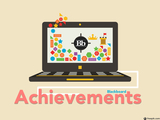Instructor adds Blackboard achievements to engineering class
Josh Enszer, a lecturer in the Chemical, Biochemical & Environmental Engineering department, has used homegrown achievements in his courses for the past three years as part of his research into gamification and student attitudes. The new Achievements tool in Blackboard, which was deployed to UMBC in January 2015, streamlined Enszer’s efforts and provided new opportunities for efficiency while continuing to increase student engagement in a core course for Engineering majors.
Blackboard Achievements support an internal badging system that is designed and controlled by the instructor. Rewarding students for a job well done is a powerful motivator, according to Blackboard, and instructors can find many opportunities to recognize students for their efforts using the Achievements tool.
Using Achievements, Enszer noticed different behaviors. While a few students admitted that they came to office hours just to earn the badge, more students were stopping by. Including a badge for finding an error in a course document meant students might read more closely. And turning in every assignment? Students earned the meme-tasic Submit ALL the Things! badge. Gamifying the course where points were earned, not lost, with Achievements as reward mechanism ultimately produced positive outcomes by focusing on accomplishments and successes, which increased morale.
None of the Achievements Enszer created result in extra points toward a grade. “One rule I’ve always followed is [that] achievements don’t impact grades,” he says. Some Achievements could be earned for doing well in the course, such as earning a high grade on the mid-term exam, but student engagement and motivation are really the focus.
Enszer also likes the “Easter Egg” aspect of Blackboard Achievements. Some rewards are hidden in the course, which makes it fun when a student discovers one by completing a particular task, while others are clearly identified. “Everyone knows the ‘come visit office hours’ achievement is attainable,” he says. Blackboard also tells Enszer which students have earned specific achievements.
The Achievements tool offers a lot of potential to an instructor, but Enszer recommends instructors getting started to begin with something simple, such as setting one where students submit a specific assignment. Many Achievements, he notes, are “set and forget” since they can be linked to the grade center and automatically unlock as students submit tests or instructors enter grades. Some achievements can be manually awarded to individual students.
When developing new projects for the course, he builds in new possibilities for achievements, which is a catalyst for creativity and professional revitalization. Gamification also helps him keep in touch with students. Upperclassmen even recommend ideas for new badges. Having previously coded many achievements by hand, Enszer notes the usefulness of the Blackboard Achievements tool. “I love the Achievements tool,” he says. “It does so much work for me that I had to do myself.”
For more information about Achievements and gamification:
- Watch the Faculty Development Center recording, Game-Based and Gamified Learning, where Josh Enszer talks about gamifying his course with Achievements (Spring 2015)
- View Josh Enszer’s screencast on gamifying his course without the Achievement tool (Fall 2012)
- Read 7 things about badges and 7 things about gamification from the EDUCAUSE Learning Initiative
- Learn how to use the Achievements tool in Blackboard
- Read more about best practices with using Achievements
- Open an RT ticket to ask a question or get support
- Attend training
Posted: May 6, 2015, 12:55 PM
